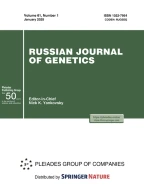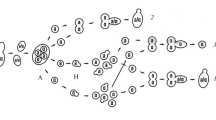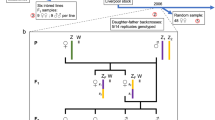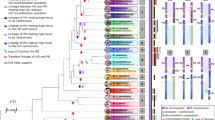Abstract
Genetic characteristics of intratetrad mating, i.e., fusion of haploid products of one meiotic division, are considered. Upon intratetrad mating, the probability of homozygotization is lower than that upon self-fertilization, while heterozygosity at genes linked to the mating-type locus, which determines the possibility of cell fusion, is preserved. If the mating-type locus is linked to the centromere, the genome regions adjoining the centromeres of all chromosomes remain heterozygous. Intratetrad mating is characteristic of a number of fungi (Saccharomyces cerevisiae, Saccharomycodes ludwigii, Neurospora tetrasperma, Agaricus bisporus, Microbotryum violaceum, and others). Parthenogenetic reproduction in some insects also involves this type of fusion of nuclei. Intratetrad mating leads to the accumulation of haplolethals (i.e., lethals manifesting in haploid cells but not hindering their mating) in pericentric chromosome regions. Since heterozygosity increases viability of an organism, recombination has been suppressed during evolution in fungi characterized by intratetrad mating, which ensures heterozygosity of the most part of the genome.
Similar content being viewed by others
REFERENCES
Mogie, M., Automixis: Its Distribution and Status, Biol. J. Linn. Soc., 1986, vol. 28, pp. 321–329.
Zakharov, I.A., Genetic Consequences of Intratetrad Mating of Ascospores in Yeasts, Vestn. Leningr. Univ., 1965, no. 9, pp. 124–129.
Zakharov, I.A., Increase in Homozygosity as a Result of Intratetrad and Intraoctad Fertilization in Fungi, Genetika (Moscow), 1968, vol. 4, pp. 98–105.
Hogben, L., An Introduction to Mathematical Genetics, New York: Norton, 1946.
Li, C.C., Population Genetics, Chicago: Univ. of Chicago Press, 1955.
Kempthorne, O., An Introduction to Genetic Statistics, New York: Wiley, 1957.
Zakharov, I.A., Mating Analysis in Microorganisms upon Sexual or Asexual Reproduction, in Genetika i selektsiya mikroorganizmov (Genetics and Selection of Microorganisms), Moscow: Nauka, 1964, p. 61.
Zakharov, I.A. and Matselyukh, B.P., Geneticheskie karty mikroorganizmov (Genetic Maps of Microorganisms), Kiev: Naukova Dumka, 1986.
Emerson, E., Meiotic Recombination in Fungi with Special Reference to Tetrad Analysis, in Methodology in Basic Genetics, San Francisco: Holden-Day, 1963, p. 167.
Lindegren, C.C., The Yeast Cell, Its Genetics and Cytology, St. Louis: Educational Publ., 1949.
Perkins, D.D., Biochemical Mutants in the Smut Fungus Ustilago maydis, Genetics, 1949, vol. 34, p. 607.
Rizet, G. and Engelmann, C., Contribution á l’étude génétique d’un Ascomycéte Tétrasporé: Podospora anserine (Ces.) Rehm., Rev. Cytol. Biol. Veget., 1949, vol. 11, p. 201.
Papazian, H., The Analysis of Tetrad Data, Genetics, 1952, vol. 37, p. 175.
Kirby, G.C., Breeding Systems and Heterozygosity in Populations of Tetrad-Forming Fungi, Heredity, 1984, vol. 52, p. 35.
Santa Maria, J., Polyploidy in Yeasts, Nature, 1958, vol. 181, p. 1740.
Sansome, E.R., Maintenance of Heterozygosity in a Homothallic Species of the Neurospora tetrasperma Type, Nature, 1946, vol. 157, p. 484.
Catcheside, D.G., The Genetics of Microorganisms, London: Pitman, 1951.
Howe, H.D., Markers and Centromere Distances in Neurospora tetrasperma, Genetics, 1963, vol. 48, p. 121.
Brefeld, O., Botanische Untersuchungen uber Hefenpilze: V. Die Brandpilze, Leipzig: Arthur Felix, 1883 (cited from [21]).
Harper, R.A., Nuclear Phenomena in Certain Stages in the Development of the Smuts, Trans. Wisconsin Acad. Sci. Arts Lett., 1899, vol. 12, pp. 475–498 (cited from [21]).
Oudemans, P.V., Alexander, H.M., Antonovics, J., et al., The Distribution of Mating-Type Bias in Natural Populations of the Anther-Smut Ustilago violacea on Silene alba in Virginia, Mycologia, 1998, vol. 90, pp. 372–381.
Guilliermond, M.A., Recherches sur la germination des spores et la conjugasion chez les levures, Rev. Gen. Bot., 1905, vol. 509, p. 337.
Whitehouse, H.L.K., Heterothallism and Sex in the Fungi, Biol. Rev., 1949, vol. 24, p. 411.
Merino, S.T., Nelson, M.A., Jacobson, D.J., and Natvig, D.O., Pseudohomothallism and Evolution of the Mating-Type Chromosome in Neurospora tetrasperma, Genetics, 1996, vol. 143, pp. 789–799.
Yamazaki, T., Ohara, Y., and Oshima, Y., Rare Occurrence of the Tetratype Tetrads in Saccharomycodes ludwigii, J. Bacteriol., 1976, vol. 125, p. 461.
Coluccio, A. and Neiman, A.M., Interspore Bridges: A New Feature of the Saccharomyces cerevisiae Spore Wall, Microbiology, 2004, vol. 150, pp. 3189–3196.
James, A.P., The Spectrum of Severity of Mutant Effects: Haploid Effects in Yeast, Genetics, 1959, vol. 44, p. 1309.
Inge-Vechtomov, S.G., New Genetic Strains of Yeast Saccharomyces cerevisiae, Vestn. Leningr. Univ., 1963, no. 21, p. 117.
Nielsen, J., Isolation and Culture of Monokaryotic Haploids of Ustilago nuda, the Role of Proline in Their Metabolism and the Inoculation of Barley with Resynthesized Dikaryons, Can. J. Bot., 1968, vol. 46, pp. 1193–1200.
Garber, E.D. and Day, A.W., Genetic Mapping of a Phytopathogenic Basidiomycete, Ustilago violacea, Bot. Gaz., 1985, vol. 146, pp. 449–459.
Garber, E.D., Eng, C., and Stevens, D.M., Genetics of Ustilago violacea: XXI. Centromere-Linkage Values and Pericentric Gene Clustering, Curr. Genet., 1987, vol. 12, pp. 555–560.
Hood, M.E. and Antonovics, J., Intratetrad Mating, Heterozygosity, and the Maintenance of Deleterious Alleles in Microbobotryum violaceum (= Ustilago violacea), Heredity, 2000, vol. 85, pp. 231–241.
Thomas, A., Shykoff, J., Jonot, O., and Giraud, T., Sex-Ratio Bias in Populations of the Phytopathogenic Fungus Microbotryum violaceum from Several Host Species, Int. J. Plant Sci., 2003, vol. 164, pp. 641–647.
Hood, M.E. and Antonovics, J., Mating within the Meiotic Tetrad and the Maintenance of Genomic Heterozygosity, Genetics, 2004, vol. 166, pp. 1751–1759.
Antonovics, J., O’Keefe, K., and Hood, M.E., Theoretical Population Genetics of Mating-Type Linked Haplo-Lethal Alleles, Int. J. Plant Sci., 1998, vol. 159, pp. 192–198.
Antonovics, J. and Abrams, J.Y., Intratetrad Mating and the Evolution of Linkage Relationships, Evolution, 2004, vol. 58, pp. 702–709.
Zakharov, I.A., Several Regularities of Gene Location in Eukaryotic Chromosomes, Genetika (Moscow), 1986, vol. 22, no.12, pp. 2620–2624.
Kerrigan, R.W., Imbernon, M., Callac, P., et al., The Heterothallic Life Cycle of Agaricus bisporus var. burnettii and Inheritance of Its Tetrasporic Trait, Exp. Mycol., 1994, vol. 18, pp. 193–210.
Volkova, V.N., Kamzolkina, O.V., Kozlova, M.V., and D’yakov, Yu.T., Comparative Karyology of Agaricus bisporus Strains with Different Types of the Life Cycle, Mikol. Fitopatol., 2003, vol. 37, pp. 30–41.
Callac, P., de Haut, I.J., Imbernon, M., and Guinberteau, J., A Novel Homothallic Variety of Agaricus bisporus Comprises Rare Tetrasporic Isolates from Europe, Mycologia, 2003, vol. 95, pp. 222–231.
Callac, P., Billette, C., Imbernon, M., and Kerrigan, R.W., Morphological, Genetic, and Interfertility Analyses Reveal a Novel, Tetrasporic Variety of Agaricus bisporus from the Sonoran Desert of California, Mycologia, 1993, vol. 85, pp. 835–851.
Callac, P., Imbernon, M., Kerrigan, R.W., and Olivier, J.-M., The Two Life Cycles of Agaricus bisporus, Mushroom Biology and Mushroom Products, Royse, D.J., Ed., Pennsylvania: Pennsylvania Univ. Press, 1996, pp. 57–66.
Sommerbell, R.C., Castle, A.J., Horgen, P.A., et al., Inheritance of Restriction Fragment Length Polymorphisms in Agaricus brunnescens, Genetics, 1989, vol. 123, pp. 293–300.
Kerrigan, R.W., Royer, J.C., Baller, L.M., et al., Meiotic Behavior and Linkage Relationships in the Secondarily Homothallic Fungus Agaricus bisporus, Genetics, 1993, vol. 133, pp. 225–236.
Asher, J.H., Parthenogenesis and Genetic Variability: II. One-Locus Models for Various Diploid Populations, Genetics, 1970, vol. 66, pp. 369–391.
Murdy, W.H. and Carson, H.L., Parthenogenesis in Drosophila mangabeirai Malog, Am. Nat., 1959, vol. 43, pp. 355–363.
Stalker, H.D., On the Evolution of Parthenogenesis in Lonchoptera (Diptera), Evolution, 1956, vol. 10, pp. 345–359.
Baudry, E., Kryger, P., Allsopp, M., et al., Whole-Genome Scan in Thelytokous-Laying Workers of the Cape Honeybee (Apis mellifera capensis): Central Fusion, Reduced Recombination Rates and Centromere Mapping Using Half-Tetrad Analyses, Genetics, 2004, vol. 167, pp. 243–252.
Nace, G.W., Richards, C.M., and Asher, J.H., Parthenogenesis and Genetic Variability: I. Linkage and Inbreeding Estimations in the Frog, Rana pipiens, Genetics, 1970, vol. 66, pp. 349–368.
Author information
Authors and Affiliations
Additional information
__________
Translated from Genetika, Vol. 41, No. 4, 2005, pp. 508–519.
Original Russian Text Copyright © 2005 by Zakharov.
Rights and permissions
About this article
Cite this article
Zakharov, I.A. Intratetrad mating and its genetic and evolutionary consequences. Russ J Genet 41, 402–411 (2005). https://doi.org/10.1007/s11177-005-0103-z
Received:
Issue date:
DOI: https://doi.org/10.1007/s11177-005-0103-z




